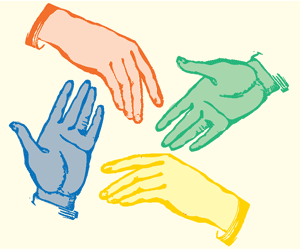Let's Shake on That!
Here's another puzzle that explores the world of functions.
Ramanujan is having a party. Since his father and mother named him after a famous Indian mathematician of the 20th century, Srinivasa Ramanujan, he always likes to have mathematical puzzles at his parties. His friends call him Rama for short. In his invitation he wrote:
|
Dear Friends, I have invited 17 boys and girls to my party. When you get here, I will shake hands with each of you, and I'd like each of you to shake hands with me and with each other just once. Before you come I'd like you to solve this puzzle: How many handshakes will take place at the party? I'll give a prize to everyone who tells me the right answer and can prove it. When you get to the party I can promise you some more puzzles. Your friend, Rama |
Challenge 1
If everyone shakes hands with everyone exactly once, 153 handshakes will take place. Can you explain why?
At the party, Rama asked his friends to solve two other puzzles.
Challenge 2
 |
Find a rule telling how many handshakes will take place among any number of people, N, if each person shakes everyone else's hand once.
Challenge 3
If you draw a polygon with N sides, and then draw all the possible diagonals, how many line segments will you draw? How does this result relate to the number of handshakes for N people?
Background
This puzzle, like others in the Algebraic Thinking category, deals with a function. Remember that in mathematicsspeak a function is a rule relating two variables, so that if you know one of the variables, called the independent variable, the rule tells you the value of the other variable, the dependent variable.
In Building With Bricks our puzzle involved "square numbers," the series 1, 4, 9, 16, 25, and so forth. In Painting Cubes we investigated "cube numbers," the series 1, 8, 27, 64, 125, and so forth. This time our pattern results in another famous series called "triangle numbers."
You may want to look up information about Srinivasa Ramanujan [1] on the Web. A BBC movie is being made about his life. There is even a rock song about his life.
Hints:
- Since this puzzle involves a function, you can approach it either inductively, starting from the simplest case and looking for a pattern, or deductively, by thinking about the general case and using reasoning to find a solution for N people.
- Some people find that making a drawing can help them solve this type of puzzle.
This content has been re-published with permission from SEED. Copyright © 2025 Schlumberger Excellence in Education Development (SEED), Inc.
- Math Puzzle [4]
- Algebra [5]
- Algebra puzzle [6]
